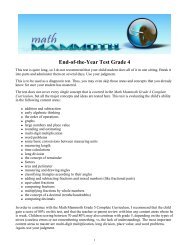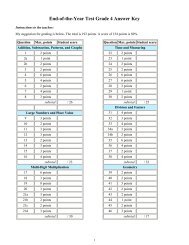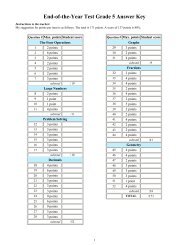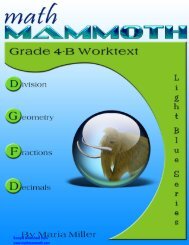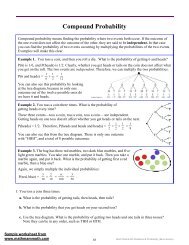End-of-the-Year Test - Grade 5
Math Mammoth Grade 5 End of the Year Test Instructions
Math Mammoth Grade 5 End of the Year Test Instructions
You also want an ePaper? Increase the reach of your titles
YUMPU automatically turns print PDFs into web optimized ePapers that Google loves.
<strong>End</strong>-<strong>of</strong>-<strong>the</strong>-<strong>Year</strong> <strong>Test</strong> - <strong>Grade</strong> 5<br />
This test is quite long, because it contains questions on all <strong>of</strong> <strong>the</strong> major topics covered in Math Mammoth<br />
<strong>Grade</strong> 5 Complete Curriculum. Its main purpose is to be a diagnostic test: to find out what <strong>the</strong> student<br />
knows and does not know. The questions are quite basic and don’t involve especially difficult word<br />
problems.<br />
Since <strong>the</strong> test is so long, I don’t recommend that you have your child or student do it in one sitting. Break<br />
it into 3-5 parts and administer <strong>the</strong>m on consecutive days, or perhaps in a<br />
morning/evening/morning/evening. Use your judgment.<br />
A calculator is not allowed.<br />
The test is evaluating <strong>the</strong> student’s ability in <strong>the</strong> following content areas:<br />
<br />
<br />
<br />
<br />
<br />
<br />
<br />
<br />
<br />
<br />
<br />
<br />
<br />
<br />
<br />
<strong>the</strong> four operations with whole numbers<br />
<strong>the</strong> concept <strong>of</strong> an equation; solving simple equations<br />
divisibility and factoring<br />
place value and rounding with large numbers<br />
solving word problems, especially those that involve a fractional part <strong>of</strong> a quantity<br />
<strong>the</strong> concept <strong>of</strong> a decimal and decimal place value<br />
all four operations with decimals, to <strong>the</strong> hundredths<br />
coordinate grid, drawing a line graph, and finding <strong>the</strong> average<br />
fraction addition and subtraction<br />
equivalent fractions and simplifying fractions<br />
fraction multiplication<br />
division <strong>of</strong> fractions in special cases (a unit fraction divided by a whole number, and a whole<br />
number divided by a unit fraction)<br />
classifying triangles and quadrilaterals<br />
area and perimeter<br />
volume <strong>of</strong> rectangular prisms (boxes)<br />
In order to continue with <strong>the</strong> Math Mammoth <strong>Grade</strong> 6 Complete Worktext, I recommend that <strong>the</strong> child<br />
gain a minimum score <strong>of</strong> 80% on this test, and that <strong>the</strong> teacher or parent review with him any content<br />
areas in which he may be weak. The exception to this rule is integers, because <strong>the</strong>y will be reviewed in<br />
detail in 6th grade. Children scoring between 70% and 80% may also continue with grade 6, depending on<br />
<strong>the</strong> types <strong>of</strong> errors (careless errors or not remembering something, versus a lack <strong>of</strong> understanding). Again,<br />
use your judgment.<br />
1
Instructions to <strong>the</strong> student:<br />
Do not use a calculator. Answer each question in <strong>the</strong> space provided.<br />
Instructions to <strong>the</strong> teacher:<br />
My suggestion for points per item is as follows. The total is 171 points. A score <strong>of</strong> 137 points is 80%.<br />
Question # Max. points Student score<br />
The Four Operations<br />
1 2 points<br />
2 6 points<br />
3 2 points<br />
4 2 points<br />
5 2 points<br />
6 2 points<br />
7 3 points<br />
subtotal / 19<br />
Large Numbers<br />
8 2 points<br />
9 1 point<br />
10 1 point<br />
11 4 points<br />
subtotal / 8<br />
Problem Solving<br />
12 3 points<br />
13 3 points<br />
14 3 points<br />
15 3 points<br />
16 3 points<br />
17 3 points<br />
subtotal / 18<br />
Decimals<br />
18 4 points<br />
19 6 points<br />
20 3 points<br />
21 3 points<br />
22 3 points<br />
23 3 points<br />
24 9 points<br />
25 6 points<br />
26 9 points<br />
27 3 points<br />
28 3 points<br />
subtotal /52<br />
Question # Max. points Student score<br />
Graphs<br />
29 3 points<br />
30 2 points<br />
31 4 points<br />
subtotal /9<br />
Fractions<br />
32 3 points<br />
33 4 points<br />
34 4 points<br />
35 2 points<br />
36 4 points<br />
37 2 points<br />
38 5 points<br />
39 3 points<br />
40 2 points<br />
41 4 points<br />
42 2 points<br />
43 2 points<br />
44 4 points<br />
subtotal /41<br />
Geometry<br />
45 4 points<br />
46 4 points<br />
47 2 points<br />
48 3 points<br />
49 3 points<br />
50 3 points<br />
51 1 point<br />
52 4 points<br />
subtotal /24<br />
TOTAL /171<br />
2
Math Mammoth <strong>End</strong>-<strong>of</strong>-<strong>the</strong>-<strong>Year</strong> <strong>Test</strong> - <strong>Grade</strong> 5<br />
The Four Operations<br />
1. Solve (without a calculator).<br />
a. 1,035 ÷ 23<br />
b. 492 × 832<br />
2. Solve.<br />
a. x – 56,409 = 240,021<br />
b. 7,200 ÷ Y = 90<br />
c. N ÷ 14 = 236<br />
3. Write an equation to match this model, and solve it.<br />
4. Place paren<strong>the</strong>ses into <strong>the</strong> equations to make <strong>the</strong>m true.<br />
a. 42 × 10 = 10 – 4 × 70 b. 143 = 13 × 5 + 6<br />
3
5. Write a single expression (number sentence) for <strong>the</strong> problem, and solve.<br />
A store was selling movies that originally cost $19.95 with a $5 discount.<br />
Mia bought five <strong>of</strong> <strong>the</strong>m. What was <strong>the</strong> total cost?<br />
6. Is 991 divisible by 4?<br />
Why or why not?<br />
7. Factor <strong>the</strong> following numbers to <strong>the</strong>ir prime factors.<br />
a. 26<br />
/ \<br />
b. 40<br />
/ \<br />
c. 59<br />
/ \<br />
Large Numbers<br />
8. Write <strong>the</strong> numbers.<br />
a. 70 million 16 thousand 90<br />
b. 32 billion 232 thousand<br />
9. Estimate <strong>the</strong> result <strong>of</strong> 31,933 × 305.<br />
4
10. What is <strong>the</strong> value <strong>of</strong> <strong>the</strong> digit 8 in <strong>the</strong> number 56,782,010,000?<br />
11. Round <strong>the</strong>se numbers to <strong>the</strong> nearest thousand, nearest ten thousand, nearest hundred thousand,<br />
and nearest million.<br />
number 593,204 19,054,947<br />
to <strong>the</strong> nearest 1,000<br />
to <strong>the</strong> nearest 10,000<br />
to <strong>the</strong> nearest 100,000<br />
to <strong>the</strong> nearest million<br />
Problem Solving<br />
12. Jack has an 8-ft long board. He cuts <strong>of</strong>f 1/6 <strong>of</strong> it.<br />
How long is <strong>the</strong> remaining piece, in feet and inches?<br />
13. A website charges a fixed amount for each song download.<br />
If you can download six songs for $4.68, <strong>the</strong>n how much would<br />
it cost to download ten songs?<br />
14. A meal in a fancy restaurant costs three times as much as a meal in <strong>the</strong> cafeteria.<br />
The meal in <strong>the</strong> fancy restaurant costs $36. In a 5-day workweek, Mary ate lunch<br />
at <strong>the</strong> fancy restaurant once, and in <strong>the</strong> cafeteria <strong>the</strong> rest <strong>of</strong> <strong>the</strong> days.<br />
How much did she spend on lunch that week?<br />
5
15. A blue swimsuit costs $42 and a red swimsuit<br />
costs 5/6 as much. How much would <strong>the</strong> two<br />
swimsuits cost toge<strong>the</strong>r?<br />
Mark <strong>the</strong> $42 in <strong>the</strong> bar model. Mark what is not<br />
known with “?”. Solve.<br />
16. A bag has green and purple marbles. Two-fifths <strong>of</strong> <strong>the</strong> marbles are green, and <strong>the</strong> rest are purple.<br />
a. Draw a bar model for this situation.<br />
b. If <strong>the</strong>re are 134 green marbles, how many are purple?<br />
17. Karen and Ann share <strong>the</strong> cost <strong>of</strong> a DVD that costs $29.90<br />
so that Karen pays 3/5 <strong>of</strong> it and Ann pays 2/5 <strong>of</strong> it.<br />
a. Estimate how much each person will pay.<br />
b. Find <strong>the</strong> exact amount <strong>of</strong> how much each person will pay.<br />
6
Decimals<br />
18. Write <strong>the</strong> decimals indicated by <strong>the</strong> arrows.<br />
a. __________ b. __________ c. __________ d. __________<br />
19. Complete.<br />
a. 0.9 + 0.05 = _________ b. 0.28 + _______ = 1 c. 0.82 − 0.2 = ________<br />
d. 1.3 − 0.04 = _________ e. 0.25 + 0.8 = _______ f. ________− 0.2 = 0.17<br />
20. Write as decimals.<br />
a.<br />
8<br />
100 = b. 81<br />
1000<br />
= c. 5<br />
21<br />
100 =<br />
21. Write as fractions or mixed numbers.<br />
a. 0.048 b. 1.004 c. 7.22<br />
22. Compare, and write < or > .<br />
a. 0.31 0.031 b. 0.43 0.093 c. 1.6 1.29<br />
23. Round <strong>the</strong> numbers to <strong>the</strong> nearest one, nearest tenth, and nearest hundredth.<br />
rounded<br />
to...<br />
nearest<br />
one<br />
nearest<br />
tenth<br />
nearest<br />
hundredth<br />
rounded<br />
to...<br />
nearest<br />
one<br />
nearest<br />
tenth<br />
nearest<br />
hundredth<br />
5.098<br />
0.306<br />
24. Solve.<br />
a. 0.4 × 7 =<br />
b. 0.4 × 0.7 =<br />
c. 0.4 × 700 =<br />
d. 10 × 0.05 =<br />
e. 100 × 0.05 =<br />
f. 1000 × 0.5 =<br />
g. 1.1 × 0.3 =<br />
h. 70 × 0.9 =<br />
i. 20 × 0.09 =<br />
7
25. Divide.<br />
a. 0.36 ÷ 6 =<br />
b. 5.6 ÷ 7 =<br />
c. 3 ÷ 100 =<br />
d. 0.7 ÷ 10 =<br />
e. 16 ÷ 10 =<br />
f. 71 ÷ 100 =<br />
26. Convert.<br />
a. 0.2 m = ___________ cm<br />
37 cm = ___________ m<br />
2.9 km = ___________ m<br />
b. 0.4 L = _________ ml<br />
3.5 kg = _________ g<br />
240 g = _________ kg<br />
c. 56 oz = ______ lb _____ oz<br />
74 in = ______ ft _____ in<br />
15 C = ______ qt _____ C<br />
27. Two liters <strong>of</strong> ice cream is<br />
divided equally into nine<br />
bowls. Calculate, to <strong>the</strong> nearest<br />
milliliter, how much ice cream<br />
is in two bowls.<br />
28. Calculate.<br />
a. 4.2 − 2.78<br />
b. 71.40 ÷ 5<br />
c. 2.2 × 6.4<br />
8
Graphs<br />
29. Plot <strong>the</strong> points from <strong>the</strong> “number rule” on<br />
<strong>the</strong> coordinate grid.<br />
The rule for x-values:<br />
Start at 0, and add 1 each time.<br />
The rule for y-values:<br />
Start at 1, and add 2 each time.<br />
x 0 1<br />
y 1<br />
30. In <strong>the</strong> grid draw a circle with a center<br />
point at (8, 4) and a radius <strong>of</strong> 3 units.<br />
31. The table below gives <strong>the</strong> amount <strong>of</strong> sales in a grocery store from Monday through Friday.<br />
Day<br />
Sales<br />
(thousands <strong>of</strong> dollars)<br />
Mon 125<br />
Tue 114<br />
Wed 118<br />
Thu 130<br />
Fri 158<br />
a. Make a line graph.<br />
b. Calculate <strong>the</strong> average daily<br />
sales for this period.<br />
9
Fractions<br />
32. Add and subtract.<br />
a.<br />
b.<br />
c. 3 7 10<br />
3 7 9<br />
5 1 6<br />
2 8 10<br />
+ 2 5 9<br />
− 2 5 6<br />
+ 7 3 10<br />
33. Mark <strong>the</strong> fractions on <strong>the</strong> number line.<br />
3<br />
4 , 1<br />
3 , 4<br />
6 , 5<br />
12<br />
34. If you can find an equivalent fraction, write it. If you cannot, cross <strong>the</strong> whole problem out.<br />
a.<br />
5<br />
6 = 20<br />
b.<br />
2<br />
7 = 28<br />
c.<br />
3<br />
8 = 15<br />
d.<br />
2<br />
9 = 6<br />
35. Find <strong>the</strong> errors in Mia’s calculation and correct <strong>the</strong>m.<br />
+ “I need <strong>the</strong>se to have <strong>the</strong> same denominator.”<br />
2<br />
5<br />
↓<br />
+<br />
2<br />
3<br />
↓<br />
+ =<br />
2<br />
15<br />
+<br />
2<br />
15<br />
=<br />
4<br />
15<br />
10
36. Add and subtract <strong>the</strong> fractions and mixed numbers.<br />
a.<br />
1<br />
3 + 5 6<br />
b.<br />
4<br />
5 − 1 3<br />
c. 6 1 8 − 1 2<br />
d. 6 7 9 + 3 1 2<br />
37. You need 2 3/4 cups <strong>of</strong> flour for one batch <strong>of</strong> rolls.<br />
Find how much flour you would need for three batches <strong>of</strong> rolls.<br />
38. Compare <strong>the</strong> fractions, and write < , >, or = in <strong>the</strong> box.<br />
a.<br />
6<br />
9<br />
6<br />
13<br />
b.<br />
6<br />
13<br />
1<br />
2<br />
c.<br />
5<br />
10<br />
48<br />
100<br />
d.<br />
1<br />
4<br />
25<br />
100<br />
e.<br />
5<br />
7<br />
7<br />
10<br />
39. Simplify <strong>the</strong> following fractions if possible. Give your answer as a mixed number when you can.<br />
a.<br />
21<br />
15 = b. 29<br />
36 = c. 42<br />
48 =<br />
40. Is <strong>the</strong> following multiplication correct?<br />
If not, correct it.<br />
2<br />
3 × =<br />
11
41. Multiply <strong>the</strong> fractions, and shade a picture to illustrate <strong>the</strong> multiplication.<br />
a.<br />
1<br />
3 × 5 6<br />
b.<br />
2<br />
9 × 2 3<br />
42. How many 1/4 ft pieces can you cut<br />
from a string that is 15 feet long?<br />
43. Three people share half a pizza evenly. What fractional<br />
part <strong>of</strong> <strong>the</strong> original pizza does each one get?<br />
44. Solve. Give your answer as a mixed number and simplified to lowest terms.<br />
a. 7 6 × 9 b. 1<br />
7 ÷ 3<br />
c. 4 5 × 3 2 3<br />
d. 2 ÷<br />
1<br />
9<br />
12
Geometry<br />
45. Measure <strong>the</strong> sides <strong>of</strong> <strong>the</strong> triangle in inches. Find its perimeter.<br />
46. Below you see two triangles and two quadrilaterals. Classify <strong>the</strong> triangles according to <strong>the</strong>ir sides<br />
and angles. Name <strong>the</strong> quadrilaterals.<br />
a. ____________________________________________________________<br />
b. ____________________________________________________________<br />
c. ____________________________________________________________<br />
d. ____________________________________________________________<br />
47. a. A square has a perimeter <strong>of</strong> 12 m. What is its area?<br />
b. A square has an area <strong>of</strong> 25 ft 2 . What is its perimeter?<br />
48. Is a square a trapezoid? Why or why not?<br />
13
49. Can an obtuse triangle be isosceles?<br />
If not, explain why not.<br />
If yes, sketch an example.<br />
50. a. Draw a right triangle with 5 cm and 7 cm perpendicular sides.<br />
b. Find its perimeter.<br />
c. Measure its angles. They measure _______°, _______°, and _______°.<br />
51. This is a rectangular prism.<br />
Find its volume.<br />
52. Mat<strong>the</strong>w has a rainwater collection tank in his yard that is rectangular,<br />
like a box. It is 1.2 m long, 60 cm wide, and 1 m tall.<br />
a. Find <strong>the</strong> volume <strong>of</strong> <strong>the</strong> tank in cubic meters.<br />
b. After a rainy night, <strong>the</strong> tank was about 1/3 full.<br />
About how many liters <strong>of</strong> water were in <strong>the</strong> tank?<br />
1 cubic meter equals 1,000 liters.<br />
14




